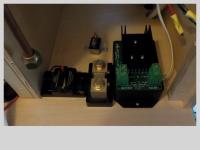I owe everyone an updated. I don't have any pics yet and I'll give a better description soon, but I've been running my 180 watt panel for a few weeks now and it just cranks out the juice! We typically would use 15 - 25 amps in a 24 hour period. I can be at 96% SOC (according to the trimetric when I back out of the shop to load up. I don't pre-chill the Engel 45qt fridge and crank it on and the fantastic fan on low and the panel is still making around 2 amps positive. I currently have completely disconnected the camper from the truck so no alternator charging. By the time we drive an hour or two to our destination, the batteries are at 100%. We stay at 100% until the sun goes down (running the Engel, fantastic fan, and lights). Overniight, we might get down to 94% SOC including running the furnace for 10 minutes (even in record breaking 95+ degree heat here in MT, the mountains can get down to 40 degrees in the morning). By 10 or 11 am, we are back up to 100% SOC.
If anyone is interested, I did work up the correct Trimeteric 2030/Solar controller (SC2030) parameters from a chart on the Exide website. Note, these only apply if you are running the FWC factory Flat Plate AGM Exide batteries. If you run other batteries, that manufacturer should be consulted with to get the correct parameters for that specific battery set. I also exchanged emails with a helpful Senior Engineer at Exide confirming all parameters. I'll post them up in the next few days.
Will have some photos of the mount as well. It was simple using the factory roof tracks and a few pieces of 1/4" aluminum bar.
I have also been looking at the Solar Blvd. 180 Watt panel priced at $200 (w shipping).
https://www.solarblv...lar-panel-copy/
AM Solar also has a 180 watt panel for $270 (w shipping). http://amsolar.com/r...els/solar-sf180
They are close to the same size and I think that both would fit between the vents on a Fleet and would span the Yakima tracks. The key difference (besides cost) is the weight. The AM Solar 180 is listed at 24.5 lbs., while the Solar Blvd. 18 is listed at 33 lbs.
Chadx, sounds like you are happy with your panel. Any issues with the weight and lifting the roof?
Edited by EnviroProf, 25 August 2017 - 10:03 PM.

















